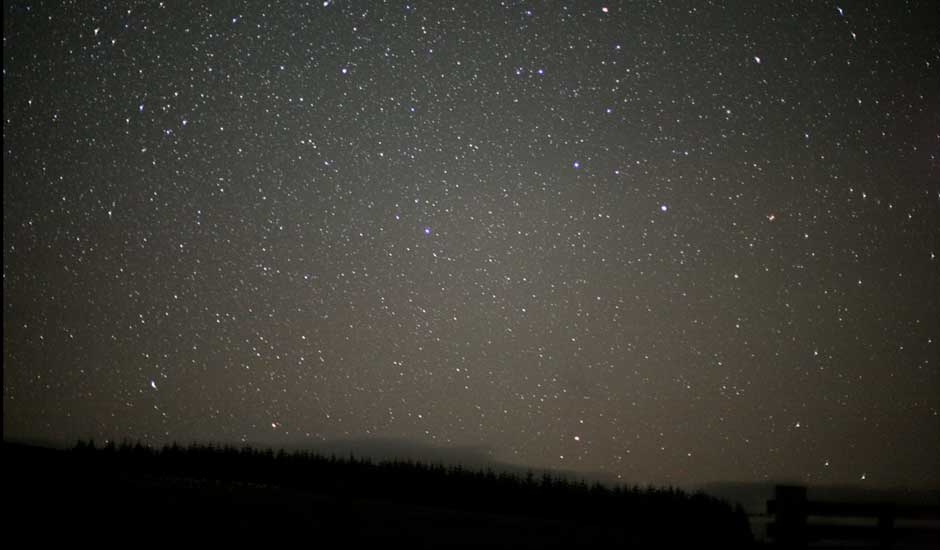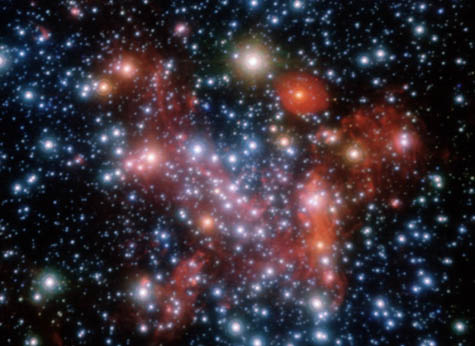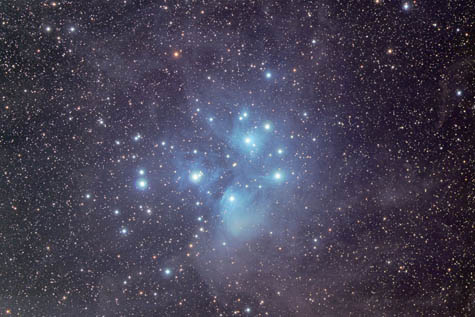Dark Sky Park
 [Image: The dark skies above Galloway Forest Park, Scotland, via the Guardian].
[Image: The dark skies above Galloway Forest Park, Scotland, via the Guardian].Note: This is a guest post by Nicola Twilley.
2009 has been designated by the United Nations as the International Year of Astronomy (IYA), marking the 400th anniversary of Galileo’s telescope. The excitement is starting early, with Galloway Forest Park in Scotland announcing its plans to become Europe’s first “dark sky park.”
The forest, which covers 300 square miles and includes the foothills of the Awful Hand Range, rates as a 3 on the Bortle scale. The scale, created by John Bortle in 2001, measures night sky darkness based on the observability of astronomical objects. It ranges from Class 9 – Inner City Sky – where "the only celestial objects that really provide pleasing telescopic views are the Moon, the planets, and a few of the brightest star clusters (if you can find them)," to Class 1 – Excellent Dark-Sky Site – where "the galaxy M33 is an obvious naked-eye object" and "airglow… is readily apparent." Class 3 is merely "Rural Sky," meaning that while "the Milky Way still appears complex... M33 is only visible with averted vision."
 [Image: The Pleiades, photographed by Thackeray's Globules, photographed by Hubble].
[Image: The Pleiades, photographed by Thackeray's Globules, photographed by Hubble].Nonetheless, Galloway Forest Park contains the darkest skies in Europe, and Steve Owens, co-coordinator of the IYA plans in the UK, is determined to gain recognition from the International Dark-Sky Association (IDA) as a lasting legacy for the 2009 celebrations.
The certification process is challenging. According to the Guardian, "to earn dark sky park status, officials in Galloway will submit digital photographs of the night sky taken through a fisheye lens. Their application must be supported by readings from light meters at different points in the park, and a list of measures that are being taken within the forest to prevent lights in and around the handful of farm buildings from spilling upwards into the sky and ruining the view."
The IDA website itself contains everything that "locations with exceptional nightscapes" need to know to submit their application to be certified as "International Dark Sky Communities (IDSC), International Dark Sky Parks (IDSP), and International Dark Sky Reserves (IDSR).” Currently, there is only one dark-sky community in the world (Flagstaff, AZ), and just two dark-sky parks (the first, Natural Bridges National Monument in Utah, and the slightly less well-known Cherry Springs State Park in northern Pennsylvania). There are no actual reserves yet; indeed, the concept is still being thrashed out in partnership with UNESCO (who issued their own Starlight Reserve framework in 2007).


 [Images: The "center of the Milky Way," photographed by the European Southern Observatory at al.; the galaxy NGC 281, photographed by Ken Crawford of the Rancho Del Sol Observatory; and the Pleiades, photographed by Philip L. Jones].
[Images: The "center of the Milky Way," photographed by the European Southern Observatory at al.; the galaxy NGC 281, photographed by Ken Crawford of the Rancho Del Sol Observatory; and the Pleiades, photographed by Philip L. Jones].The idea of a human-created dark sky park is fascinating, of course, as are the architectural and landscape modifications that must be undertaken by town councils and park management services in order to secure a qualifying Bortle score. For example, Observatory Park in Montville Township, Ohio, has been awarded provisional IDSP status (Silver Tier), contingent on "the completion of the park’s outdoor lighting scheme, visitor’s center, and enactment of outdoor lighting ordinances in surrounding townships." The Geauga Park District submitted their 34-page Lighting Management Plan (read the PDF) in August 2008, detailing various proposals for the reduction of local skyglow (as opposed to natural airglow), light trespass, and glare. These include full shading for all light installations and lighting curfews, as well as strategic tree planting.
The concept of shaping the ground to frame and enhance the sky is not new (for instance, James Turrell’s Skyscapes are an architectural attempt to achieve "light effects and perceptual events" centered on a complex reframing of the sky). Nonetheless, the idea of rebuilding and landscaping an entire community specifically for the purposes of experiencing darkness is an exciting one – as is the idea of UNESCO, official protector of World Heritage Sites, attempting to safeguard dark skies as a "natural and cultural property."
Scotland, with its northerly latitude and constant rain (which cleans the atmosphere of dust), has perhaps discovered its global tourist niche: A spokesman for VisitScotland, which is working closely with Dark Sky Scotland, ventured that "the night sky could be as important for tourism as the landscape."





Comments are moderated.
If it's not spam, it will appear here shortly!
nic: note also james turrell's (apparently succesful) efforts to keep flagstaff, az's night light levels low. flagstaff being the largest city near roden crater.
http://www.flagstaffdarkskies.org/
Kipple, thanks for the comment - I didn't realize Turrell was involved in securing Flagstaff's Dark-Sky status - interesting! N
An interesting article, but I must object on the claim that Scotland has the darkest skies in Europe; surely those are found in northern Scandinavia. See these light pollution maps: http://www.inquinamentoluminoso.it/worldatlas/pages/fig1.htm and
http://en.wikipedia.org/wiki/File:Light_pollution_europe.jpg
Illka - Thanks for linking to these maps - it does look as though there's a patch of northern Sweden that's darker than northern Scotland. My source for the claim, by the way, was this article from The Herald.
The link to the APOD had a further link to some incredible animations of infrared observations (over the past 16 years) of the stars being pulled apart by the black hole in the center of our galaxy, the Milky Way. Truly amazing.
Nicola, too bad there's no comment link on the Herald site :) And too bad they don't list sources, nor give credit to the author. Oh well.
Don't forget the Kielder Observatory on the Scottish Border, in Northumberland. It's close to a Turrell Piece, and in an area of low light pollution.
It has a fantastic observatory designed by Charles Barclay Architects for star gazing in place.
http://www.kielderobservatory.org and http://clients.crumpled-dog.com/CharlesBarclay/Projects/Projects_detail.asp?IDProject=77
Post a Comment